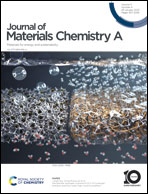Cooperative interaction between Cu and sulfur vacancies in SnS2 nanoflowers for highly efficient nitrate electroreduction to ammonia†
Abstract
Achieving high efficiency in nitrate (NO3−) to ammonia (NH3) electrocatalysis requires the exploration of advanced electrocatalysts with a well-designed composition. In this work, a facile one-step hydrothermal method was applied for the construction of novel Cu doped SnS2 nanoflowers with rich sulfur vacancies (Cu-SnS2−x). Two-dimensional Cu-SnS2−x nanosheet arrays could increase the exposure of catalytically active metal centers due to the Cu doping strategy and the generated sulfur vacancies are able to synergistically improve the electrocatalytic activity over the metal active centers. Benefiting from the cooperative interaction between Cu and S, Cu-SnS2−x nanoflowers achieved excellent performance for nitrate reduction to ammonia with a superior NH3 yield (0.63 mmol h−1 mgcat−1) and faradaic efficiency (93.8%) at −0.7 V (vs. RHE), which are almost twice those of pristine SnS2. 15N isotope labeling experiments further verify that the source of the produced ammonia is Cu-SnS2−x. DFT calculations demonstrated that sulfur vacancies cause free electron transfer to Sn, which enhances the adsorption capacity and the Cu can further regulate the electron distribution and stabilization intermediates, leading to a high ammonia yield and faradaic efficiency. The present study opens new avenues for the rational construction of efficient electrocatalysts for the synthesis of ammonia from nitrate.



 Please wait while we load your content...
Please wait while we load your content...